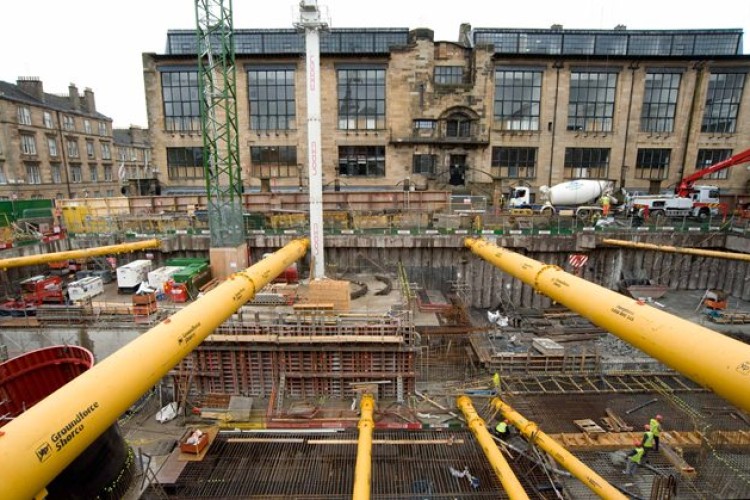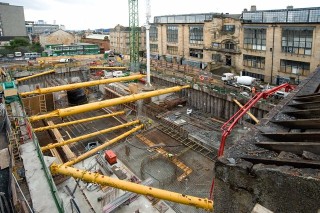The project involves construction of a new five-storey building in Renfrew Street, directly opposite the famous Grade A listed art school building designed by Charles Rennie Mackintosh.
The substructure of the new building requires temporary propping during the construction of the double storey basement in an excavation measuring approximately 60m x 34m x 10m deep.
McAlpine opted for a propping solution over structural steel because it offered the benefits of speed of installation and the capability to monitor loads, said Groundforce technical sales manager Mark Whitmore. The cost was roughly the same.
The support structure comprises nine hydraulic props in total; six at the upper level and three raking props at the lower level. As the site slopes quite steeply, all props are also on a vertical incline, meaning that Groundforce had to ensure that the end bearing plates, which are designed to permit lateral articulation, were rotated 90° to suit the connection detail on the capping beam.
As there was a need to measure the effect of the basement excavation on the surrounding buildings, wireless load monitoring system was used, which uses electronic load pins to log prop loads and transmit readings to a central server via GPRS. This data is then displayed in the form of charts and graphs on a secure website which the client, and any other authorised users, can access at any time.
Using the modular hydraulic system in combination with active load monitoring allowed Groundforce and McAlpine to be fluid with the design requirements which provided flexibility to change aspects of the design to accommodate changes to the construction sequence. The wireless load monitoring system enabled McAlpine to adopt an observational approach to the lower level propping, so it could significantly reduce the number of struts required.

One of the props is 150-tonne capacity. All of the others are 250-tonne capacity MP250 hydraulic units with 610mm diameter steel tube extensions. “With the two upper level central props, which have a the relatively long span of around 31.5m, we had to specify our 1220mm-diameter Super tubes,” Mr Whitmore said.
Delivery started during the first week of May 2012 with the total duration expected to be around five to six months. However progress has been quicker than SRM had anticipated with the lower level of props scheduled for removal mid August with the upper level removed during September.
“I’ve worked with smaller equipment, like hydraulic manhole braces, many times before, but this is a whole different order of scale” says McAlpine construction manager Peter Unwin. “Instead of handling units weighing 250-500 kg, you’re handling pieces weighing 16 or 18 tonnes. But it’s very user-friendly and everything’s gone very smoothly.”
When completed the new building, designed by New York-based Steven Holl Architects and Glasgow practice JM Architects, will house a range of studios and teaching facilities as well as workshops, communal areas and exhibition spaces.
Got a story? Email news@theconstructionindex.co.uk




